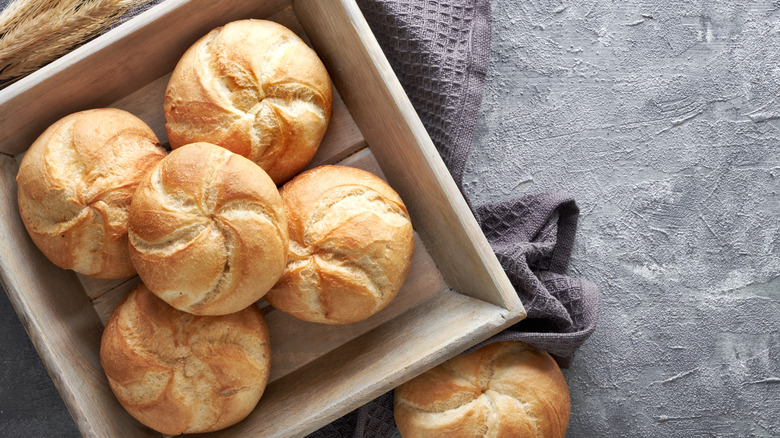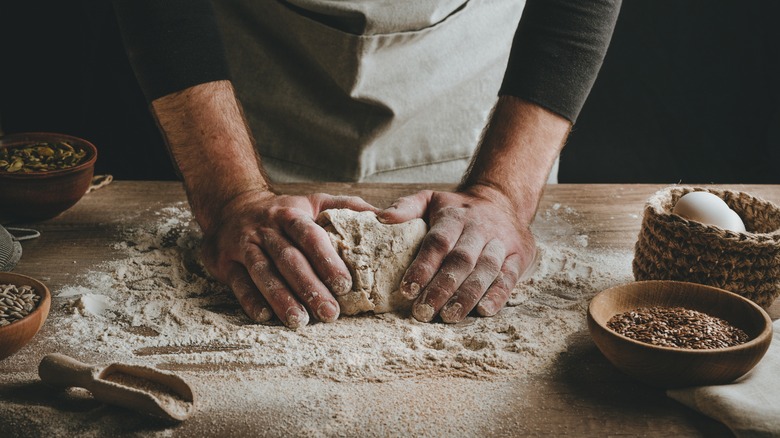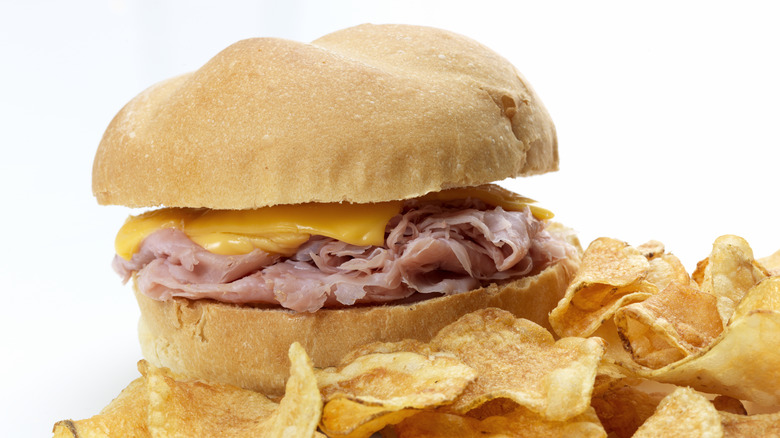Kaiser Rolls Vs. Hard Rolls: What's The Difference?
Bagels may steal all the attention, but they aren't the only New York bread made for eating on the go. There's the venerable buttered roll, a quick and affordable staple of delis and street carts. And sometimes with an order, you get handed a Kaiser roll, or other times, a hard roll. Either way, it's large, round, and topped with sesame and poppy seeds — is there really much of a difference?
Turns out, there is, and it all stems from a bit of food history. Kaiser rolls, beloved across Europe and North America, emerged in the 18th century. It was first pictured in a painting from 1760 and are originally an Austrian creation, which later spread into separate variations in other countries — including the United States.
Bakers in the U.S. began to make versions with a more crispy exterior, often dusted with cornmeal. Its new name "hard roll" likely emerged during the First World War to cut German affiliations; however, exact details are unclear. What is certain is that both versions are delicious and made in a similar fashion.
How are Kaiser and hard rolls made?
In Austria, Kaiser rolls are traditionally made with yeast, water, salt, white flour, and malt. In fact, such a recipe is federally protected by the Austrian government. But as a popular bread with many variations, there is a large assortment of preparation techniques.
Most versions reach for all-purpose flour mixed in with dry yeast, sugar, and an egg. Some rely upon butter for the fat; others call upon canola or another type of oil. The dough goes through a quick 1-hour rise and then bakes for around 20 minutes. To achieve its characteristic Kaiser twist, it's stamped or molded by hand. And before serving, the bread is sprinkled with the characteristic poppy or sesame seed topping.
Hard rolls rely upon a similar creation process, just with a few tweaks to create a more crisp exterior and airy interior. Only an egg white is incorporated, and bread flour is used instead of all-purpose. Bread flour's higher protein content gives the bake a sturdier, less soft texture. Unsurprisingly, these crispier rolls spend a bit more time in the oven — closer to half an hour. And before serving, they even get an additional five minutes for crunch.
How to cook with and find Kaiser and hard rolls
The two breads are delicious when enjoyed on their own. Hard rolls were once a popular on-the-go breakfast option, especially in New York City. Their airy interior is a perfect vessel for a slice of butter or margarine. To incorporate more sustenance, consider adding peanut butter, banana, and a compote or jam. The bread's crispier texture matches well with a sweet, soft element.
However, both rolls also make great savory sandwiches. Kaiser rolls are ideal for sopping up a variety of fillings, paired with a soft texture that's easy to bite into. This makes them a great vessel for meat-based sandwiches such as Baltimore's Pit Beef and Buffalo's Beef on Weck. But being elaborate isn't mandatory; familiar cold cuts and cheeses do just fine on either type of roll.
Both Kaiser and hard rolls are available for sale at large grocery bakeries, as well as some boutique operations such as Three Brothers Bakery or DiCamillo Bakery. For added convenience, some purveyors like Rich's even sell the premade dough. While ordering them online is possible, you'll want to bake your own for the freshest batch — nothing quite beats a sandwich on bread still warm from the oven.


